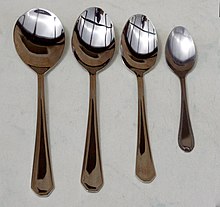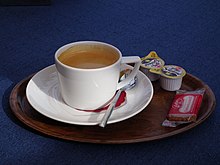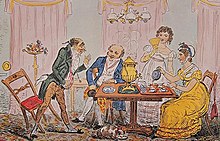Teaspoon

- Serving spoon
- Tablespoon(tbsp.)
- Dessert spoon(dsp.)
- Teaspoon (tsp.)
Ateaspoon(tsp.) is an item ofcutlery.It is a smallspoonthat can be used to stir a cup of tea or coffee, or as a tool formeasuringvolume.[1][2]The size of teaspoons ranges from about 2.5 to 7.3 mL (0.088 to 0.257 imp fl oz; 0.085 to 0.247 US fl oz). For cooking purposes and dosing of medicine, a teaspoonful is defined as 5 mL (0.18 imp fl oz; 0.17 US fl oz), and standardmeasuring spoonsare used.[3]
Cutlery[edit]

A teaspoon is a smallspoonsuitable for stirring and sipping the contents of a cup ofteaorcoffee,or adding a portion of loose sugar to it. These spoons have heads more or less oval in shape. Teaspoons are a common part of aplace setting.
Teaspoons with longer handles, such asiced tea spoons,are commonly used also forice creamdesserts orfloats.Similar spoons include thetablespoonand thedessert spoon,the latter intermediate in size between a teaspoon and a tablespoon, used in eating dessert and sometimes soup or cereals. Much less common is the coffee spoon, which is a smaller version of the teaspoon, intended for use with the small type of coffee cup.[4]Another teaspoon, called anorange spoon(in American English: grapefruit spoon), tapers to a sharp point or teeth, and is used to separatecitrus fruitsfrom their membranes. Abar spoon,equivalent to a teaspoon, is used in measuring ingredients formixed drinks.
A container designed to hold extra teaspoons, called aspooner,usually in a set with a covered sugar container, formed a part of Victorian table service.
History[edit]

The teaspoon is a European invention.[6]Small spoons were common in Europe since at least the 13th century. These special spoons were introduced almost simultaneously with tea and coffee[6](Pettigrew points to use in the mid-17th century[7]). Originally teaspoons were exotic items, precious and small, resembling thedemitasse spoonsof the later times.[6]Also used for coffee, these spoons were usually made ofgilt silver,and were available with a variety of handle shapes: plain, twisted, decorated with knobs,[7]also known asknops,hence theknop-topname for such spoons.[8]Widespread use and modern size date back to theGeorgian era.[6] The teaspoon is first mentioned in an advertisement in a 1686 edition of theLondon Gazette,[9][10]teaspoons, probably of English origin, are present on the 1700 Dutch painting byNicholas Verkolje,"A Tea Party".[11]
A special dish for resting the teaspoons, a "spoon boat",was a part of thetea setin the 18th century.[12]At that time, the spoons were playing important role in the tea drinking etiquette: a spoon laid "across" the teacup indicated that the guest did not need any more tea, otherwise, the hostess was obligated to offer a fresh cup of tea, and it was considered impolite to refuse the offering.[13][14]Pettigrew reports that sometimes the spoons were numbered to make it easier to match the cups with the guests after a refill.[13]
Unit of measure[edit]
| teaspoon | |
|---|---|
 Measuring spoons, with the second largest one representing the volume of a teaspoon. | |
| General information | |
| Unit system | Imperial units,US customary units |
| Unit of | Volume |
| Symbol | tsp |
| Conversions (imperial) | |
| 1 imp tspin... | ... is equal to... |
| SI units | 5.919 mL |
| US customary units | 1.201 US tsp |
| Conversions (US) | |
| 1 US tspin... | ... is equal to... |
| SI units | 4.929 mL |
| Imperial units | 0.833 imp tsp |
In some countries, a teaspoon (occasionallyteaspoonful) is acooking measureofvolume,especially widely used in cooking recipes and pharmaceutic medical prescriptions. In English it is abbreviated astsp.or, less often, ast.,ts.,ortspn..The abbreviation is never capitalized because a capital letter is customarily reserved for the largertablespoon( "Tbsp.", "T.", "Tbls.", or "Tb." ).[15]
A small scale study in Greece found that household teaspoons are a poor approximation of the standard tsp measure. The study investigated the accuracy of teaspoons as a measuring tool for liquid medicine. They surveyed 71 teaspoons from 25 houses and found that the volume varied between 2.5 and 7.3 ml (0.088 and 0.257 imp fl oz; 0.085 and 0.247 US fl oz).[16]
Metric teaspoon[edit]
The metric teaspoon as a unit of culinary measure is 5 ml (0.18 imp fl oz; 0.17 US fl oz),[17]equal to5cm3,1⁄3UK/Canadian metric tablespoon, or1⁄4Australian metric tablespoon.[18]
United States customary unit[edit]
As a unit of culinary measure, one teaspoon in the United States is1⁄3tablespoon,exactly4.92892159375ml, 11⁄3USfluid drams,1⁄6USfl oz,1⁄48US cup,1⁄768US liquidgallon,or77⁄256(0.30078125)cubic inches.
For nutritional labeling and medicine in the US, the teaspoon is defined the same as a metric teaspoon—precisely 5millilitres (mL).[19]
Dry ingredients[edit]
For dry granular or powdered ingredients (e.g.,salt,flour,spices,and especially beverages involvingteaandsugar),[20]a recipe may call for the spoon to be filled in a certain way that changes the volume of the ingredient. As with much of cooking, these measures are by their nature inexact. This can be exacerbated here by failing to use a real teaspoon: a teaspoon's greater area supports considerably more to be heaped above it than a deeper hemispherical measuring spoon, so if using a measuring spoon, one will typically use less than called for by the recipe. The definitions of "spoonful" vary, in particular, in a typical American recipe a "spoon" without clarification stands for a "level" spoon (the one with no ingredient showing above the rim of the spoon bowl), while a British cookbook would mean a "round" or "heaped" spoon, with the ingredient peaking above the rim:[21]
- Ascantteaspoon is one which has been filled to slightly less than level.[22]
- Alevelteaspoon, which is the defaultteaspoonif no adjective is given, refers to an approximately leveled filling of the spoon, producing the same volume as for liquids. The excess of ingredient can be scraped off by a knife.[23]
- Aroundedteaspoon is roughly symmetrical with as much ingredient above the rim as is in the spoon below the rim, giving a measure roughly equivalent to two level teaspoons.[23]
- Aheaping(North American English) orheaped(UK English) teaspoon is a larger inexact measure consisting of the amount obtained by scooping the dry ingredient up as high as possible to balance on a spoon. This quantity can vary considerably, up to 5 amounts of ingredient in the level spoon.[23]Many cookbooks treat heaped and rounded spoons interchangeably.[24][25]
Lincoln used the spoon measure without adjectives to define either a rounded one (for flour and sugar) or a level one (for salt and spices).[26]
Apothecary[edit]
As an unofficial but once widely used unit ofapothecaries' measure,the teaspoon is equal to 1 fluid dram (or drachm) and thus1⁄4of a tablespoon or1⁄8of a fluid ounce.[27][28]The apothecaries' teaspoon was formally known by the Latincochleare minus(cochl. min.) to distinguish it from the tablespoon orcochleare majus(cochl. maj.).[29][30]
When tea-drinking was first introduced to England circa 1660, tea was rare and expensive, as a consequence of which teacups and teaspoons were smaller than today. This situation persisted until 1784, when theCommutation Actreduced the tax on tea from 119% to 12.5%.[31]As the price of tea declined, the size of teacups and teaspoons increased. By the 1850s, the teaspoon as a unit of culinary measure had increased to1⁄3of a tablespoon, but the apothecary unit of measure remained the same.[32]Nevertheless, the teaspoon, usually under its Latin name, continued to be used in apothecaries' measures for several more decades, with the original definition of one fluid dram.
See also[edit]
- Bar spoon
- Caddy spoon,a specialized spoon used for taking dried tea out of a storage container
- Cooking weights and measures
- Dessert spoon
- Tablespoon
References[edit]
- ^Marie O'Toole, ed. (6 June 2013).Mosby's Medical Dictionary, 9th edition.Elsevier Health Sciences. p. 1746.ISBN978-0323112581.
- ^Charles Sinclair (January 2009).Dictionary of Food: International Food and Cooking Terms from A to Z.A&C Black.ISBN9781408102183.
- ^"Spoons give wrong medicine doses".NHS UK.15 July 2010. Archived fromthe originalon 11 November 2020.Retrieved21 February2020.
- ^T. S. Eliot's poemThe Love Song of J. Alfred Prufrockmentions coffee spoons: "For I have known them all already, known them all: / Have known the evenings, mornings, afternoons, / I have measured out my life with coffee spoons;"
- ^Pettigrew 2001,p. 84.
- ^abcdUkers 1935,p. 448.
- ^abPettigrew 2001,p. 37.
- ^Veitgh 1923,p. 121.
- ^"Home: Oxford English Dictionary".oed.com.
- ^"London Gazette Issue 2203 27 December 1686 page 2 'three small gilded Tea Spoons'".
- ^Pettigrew 2001,p. 25.
- ^Pettigrew 2001,p. 81.
- ^abPettigrew 2001,p. 85.
- ^Roth 1961,p. 72.
- ^In German and Dutch, teaspoon is abbreviatedTL,forTeelöffelandTheelepelrespectively.
- ^Falagas et al. 2010,p. 1185.
- ^21CFR (Code of Federal Regulations)101.9(b)(5)(viii)
- ^"How to Convert Cup to Tablespoon?".Airo.8 June 2016. Archived fromthe originalon 17 June 2016.Retrieved16 June2016.
- ^21CFR101.9(b)(5)(viii)2 1CFR101.9
- ^Souter, Keith (2013).The Tea Cyclopedia.Skyhorse Publishing. p. 92.ISBN9781628735482.
- ^Grigson 2007,p. xviii.
- ^Baggett 2012.
- ^abcBBC 1945.
- ^Collister 2012.
- ^Henderson & Gellatly 2008.
- ^Lincoln 1903,p. 24.
- ^Robert Borneman Ludy (1907).Answers to questions prescribed by pharmaceutical state boards.J.J. McVey. p. 125.
- ^Dr. Collins (1803).Practical rules for the management and medical treatment of Negro slaves in the sugar colonies.Printed by J. Barfield, for Vernor and Hood. p. 465.
- ^Alexander Whitelaw,ed. (1884).The popular encyclopedia; or, 'Conversations Lexicon'.p. 11.
- ^Henri Milne-Edwards; Pierre Henri L.D. Vavasseur (1831).A manual of materia medica and pharmacy, from the Fr. of H.M. Edwards and P. Vavasseur, corrected by J. Davies.p. 12.
- ^Tea.co.uk. (2020). UK Tea & Infusions Association – Illicit Tea Trades. [online] Available at:https://www.tea.co.uk/tea-smuggling[Accessed 1 February 2020].
- ^Robert Eglesfeld Griffith (1859).A universal formulary: containing the methods of preparing and administering officinal and other medicines. The whole adapted to physicians and pharmaceutists.H.C. Lea. p. 25.
Sources[edit]
- Ukers, William Harrison (1935). "Evolution of tea-making appliances".All about Tea, Volume 2.Tea and coffee trade journal Company. pp. 436–448.OCLC1201914.
- Pettigrew, Jane (2001).A Social History of Tea.National Trust.ISBN978-0-7078-0289-3.OCLC1008339683.
- Falagas, M. E.; Vouloumanou, E. K.; Plessa, E.; Peppas, G.; Rafailidis, P. I. (August 2010)."Inaccuracies in dosing drugs with teaspoons and tablespoons: Drug dosing with teaspoons/tablespoons".International Journal of Clinical Practice.64(9): 1185–1189.doi:10.1111/j.1742-1241.2010.02402.x.PMID20653796.S2CID3062421.
- Veitgh, Henry Newton (October 1923)."Spoons Of Old English Plate".International Studio.LXXVIII(317): 121–124.
- Roth, Rodris (1961)."Tea Drinking in 18th-Century America: Its Etiquette and Equipage".United States National Museum Bulletin.225(Contributions from the Museum of History and Technology). Washington, DC:Smithsonian Institution:61–91.
- Grigson, Jane (1 April 2007)."Spoon Measurements".Jane Grigson's Vegetable Book.U of Nebraska Press. p. xviii.ISBN978-0-8032-5994-2.OCLC1102099392.
By a heaped spoon, I mean as much of the ingredient as you can balance on a spoon-shaped spoon... In England, by tradition, all spoon measurements given in recipes were rounded; in other words, there was as much above the rim of the spoon as below it
- BBC(13 December 1945)."Recipes for the Housewife".Listener.34:715.
level spoon means level with the edges of the bowl; use a knife to level off... rounded spoon means as much above the bowl as you have in it: it is equal to 2 level spoons... heaped spoon means as much as you can pile up onto the spoon: it is equal to 3, 4 or 5 level
- Baggett, Nancy (11 September 2012).Simply Sensational Cookies: Bright Fresh Flowers, Natural Colors & Easy, Streamlined Techniques.Houghton Mifflin Harcourt.ISBN978-0-544-18813-6.OCLC1132332173.
Scant means that the spoon or cup should not be quite full
- Collister, Linda (25 October 2012)."Spoon Measures - Level and Rounded".Great British Bake Off: Learn to Bake: 80 easy recipes for all the family.Random House.ISBN978-1-4481-4051-0.OCLC1100934893.
- Henderson, Fergus; Gellatly, Justin Piers (6 December 2008)."Conversion Tables".Beyond Nose to Tail: More Omnivorous Recipes for the Adventurous Cook.Bloomsbury Publishing USA.ISBN978-1-59691-805-4.OCLC858912920.
- Lincoln, Mary Johnson Bailey (1903)."Measuring".Boston School Kitchen Text-book: Lessons in Cooking for the Use of Classes in Public and Industrial Schools.Little, Brown. p. 24.OCLC4053808.
A tablespoonful of flour, sugar and butter is a rounded spoonful. A teaspoonful of salt, soda, pepper and spice is a level spoonful. A heaped spoonful is all the spoon will hold
External links[edit]
- UK National Health Service (NHS)Spoons give wrong medicine doses(Archived version of "retired" NHS page.)
- US National Institutes of Health (NIH) MedlinePlusLiquid medication administration
